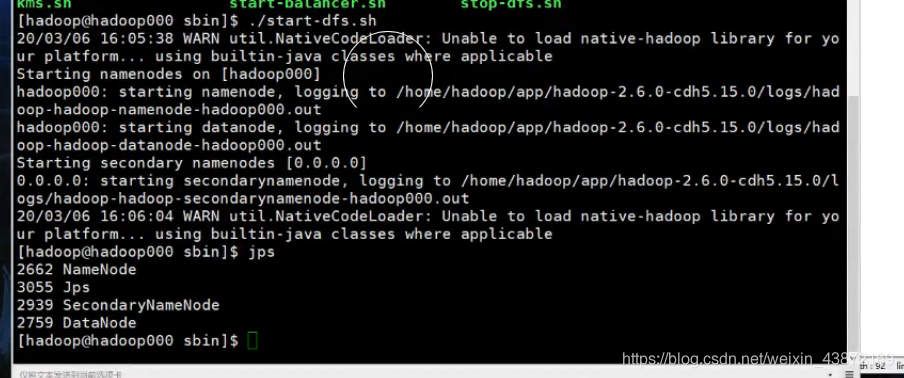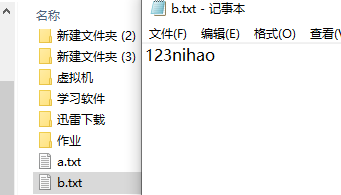一 启动hdfs:在sbin目录下./start-dfs.sh,然后jps检测。

二 HDFS的shell命令
首先追加hadoop环境变量


重启使之生效


1…创建一个文件:hadoop fs -mkdir (-p )hello.txt

2…查看文件
hadoop fs -ls (-R )目录 (-R是查看全部文件)
hadoop fs -cat 文件名



3…移动文件
hadoop fs -put 文件 hdfs路径
就是把本地文件上传到hdfs’系统中


4…复制文件
hadoop fs -cp 文件 复制的位置


5…删除文件
hadoop fs -rm -r 文件名(/hello.txt)

6…重命名文件
hadoop fs -mv 源文件 改的名字文件


7…get 命令:从hdfs系统中取文件下来到本地
hadoop fs -get hdfs中文件 本地目录

三 Java API操作HDFS文件
1.IDEA+Maven创建Java工程
new projects然后选maven,配置maven(详细可以查看csdn的其他人写的配置maven。非常详细)直到idea显示sucess为止。
在里面添加hadoop版本,这样下面添加依赖时就可以直接用了



porm.xml
<?xml version="1.0" encoding="UTF-8"?>
<project xmlns="http://maven.apache.org/POM/4.0.0" xmlns:xsi="http://www.w3.org/2001/XMLSchema-instance"
xsi:schemaLocation="http://maven.apache.org/POM/4.0.0 http://maven.apache.org/xsd/maven-4.0.0.xsd">
<modelVersion>4.0.0</modelVersion>
<groupId>org.example</groupId>
<artifactId>0410</artifactId>
<version>1.0-SNAPSHOT</version>
<name>0410</name>
<!-- FIXME change it to the project's website -->
<url>http://www.example.com</url>
<properties>
<project.build.sourceEncoding>UTF-8</project.build.sourceEncoding>
<maven.compiler.source>1.7</maven.compiler.source>
<maven.compiler.target>1.7</maven.compiler.target>
<hadoop.version>2.6.0-cdh5.15.0</hadoop.version>
</properties>
<repositories>
<repository>
<id>cloudera</id>
<url>https://repository.cloudera.com/artifactory/cloudera-repos/</url>
</repository>
</repositories>
<dependencies>
<dependency>
<groupId>org.apache.hadoop</groupId>
<artifactId>hadoop-client</artifactId>
<version>${
hadoop.version}</version>
</dependency>
<dependency>
<groupId>junit</groupId>
<artifactId>junit</artifactId>
<version>4.11</version>
<scope>test</scope>
</dependency>
<dependency>
<groupId>org.testng</groupId>
<artifactId>testng</artifactId>
<version>RELEASE</version>
<scope>test</scope>
</dependency>
<dependency>
<groupId>org.testng</groupId>
<artifactId>testng</artifactId>
<version>RELEASE</version>
<scope>test</scope>
</dependency>
</dependencies>
<build>
<pluginManagement><!-- lock down plugins versions to avoid using Maven defaults (may be moved to parent pom) -->
<plugins>
<!-- clean lifecycle, see https://maven.apache.org/ref/current/maven-core/lifecycles.html#clean_Lifecycle -->
<plugin>
<artifactId>maven-clean-plugin</artifactId>
<version>3.1.0</version>
</plugin>
<!-- default lifecycle, jar packaging: see https://maven.apache.org/ref/current/maven-core/default-bindings.html#Plugin_bindings_for_jar_packaging -->
<plugin>
<artifactId>maven-resources-plugin</artifactId>
<version>3.0.2</version>
</plugin>
<plugin>
<artifactId>maven-compiler-plugin</artifactId>
<version>3.8.0</version>
</plugin>
<plugin>
<artifactId>maven-surefire-plugin</artifactId>
<version>2.22.1</version>
</plugin>
<plugin>
<artifactId>maven-jar-plugin</artifactId>
<version>3.0.2</version>
</plugin>
<plugin>
<artifactId>maven-install-plugin</artifactId>
<version>2.5.2</version>
</plugin>
<plugin>
<artifactId>maven-deploy-plugin</artifactId>
<version>2.8.2</version>
</plugin>
<!-- site lifecycle, see https://maven.apache.org/ref/current/maven-core/lifecycles.html#site_Lifecycle -->
<plugin>
<artifactId>maven-site-plugin</artifactId>
<version>3.7.1</version>
</plugin>
<plugin>
<artifactId>maven-project-info-reports-plugin</artifactId>
<version>3.0.0</version>
</plugin>
</plugins>
</pluginManagement>
</build>
</project>
2.通过JavaAPI对HDFS系统进行操作
package org.example;
import org.apache.hadoop.conf.Configuration;
import org.apache.hadoop.fs.FSDataOutputStream;
import org.apache.hadoop.fs.FileSystem;
import org.apache.hadoop.fs.Path;
import org.junit.After;
import org.junit.Before;
import org.junit.Test;
import java.net.URI;
public class HDFSapp {
public static final String HDFS_PATH="hdfs://192.168.1.65:8020";
//定义一个HDFS文件系统的对象
FileSystem fileSystem = null;
//HDFS配置对象
Configuration configuration= null;
///准备工作(构造个函数)
@Before //单元测试
public void setUp() throws Exception{
System.out.println("HDFSapp.SetUp()");
configuration=new Configuration();
fileSystem=FileSystem.get(new URI(HDFS_PATH),configuration,"lqz");
}
//创建文件目录
@Test
public void mkdir()throws Exception{
fileSystem.mkdirs(new Path("/hdfstest0410/test"));
}
//创建文件
@Test
public void create()throws Exception{
FSDataOutputStream output =fileSystem.create(new Path("/hdfstest0410/test/lqz0410.txt")); //FSData是返回值
output.write("hello world!".getBytes()); //追加hello world 以字节码的形式写进文件
output.flush();//刷新
output.close();//关闭文件
}
//结束工作
@After
public void tearDown() throws Exception{
configuration=null;
fileSystem=null;
System.out.println("结束工作");
}
//查看文件内容
@Test
public void cat()throws Exception{
FSDataInputStream inputStream = fileSystem.open(new Path("/hdfstest0410/test/lqz0410.txt"));
IOUtils.copyBytes(inputStream,System.out,1024);
inputStream.close();
}
}





上面是主要的代码,下面是测试代码


//删除文件
@Test
public void delete()throws Exception{
fileSystem.delete(new Path("/1234"),true);
//recursive 相当于rm -r,如果是true将整个一个子目录甚至文件夹删除,默认目录是删除不掉的,ture才可以删除
}


//重命名文件
@Test
public void rename()throws Exception{
Path oldPath=new Path("/hdfstest0410/test/lqz0410.txt");
Path newPath=new Path("/hdfstest0410/test/0410.txt");
fileSystem.rename(oldPath,newPath);//旧名字,新名字
}


//复制文件,从本地上传到HDFS
//copyFromLocalFile从本地上传到hdfs,如果hdfs是一个文件那么就把文件内容复制到hdfs中的文件中去
//如果hdfs是一个目录,默认把文件拷贝到该目录下
@Test
public void copyFileFromLocalToHDFS()throws Exception{
Path localPath=new Path("D:\\a.txt");
Path hdfsPath=new Path("/hdfstest0410/test/0410.txt");
fileSystem.copyFromLocalFile(localPath,hdfsPath);//从本地拷贝到hdfs
}
此时就是把内容复制过去

//下载文件从hdfs拷贝到本地
@Test
public void copyToLocalFile()throws Exception{
Path localPath=new Path("D:\\b.txt");
Path hdfsPath=new Path("/hdfstest0410/test/0410.txt");
fileSystem.copyToLocalFile(false,hdfsPath,localPath,true);//从hdfs拷贝到本地
//false表示不在原来的文件中(hdfs)删除内容,true是按照源文件方法将内容拷贝下来
//是否删除dfs中的目录,是否用本地fs系统
}

@Test
public void listFiles()throws Exception{
FileStatus[] fileStatus = fileSystem.listStatus(new Path("/"));
//输出
for (FileStatus fileStatuse:fileStatus){
String isdir=fileStatuse.isDirectory()?"文件夹":"文件";//判断是否是目录,是就执行文件夹,不是执行文件
short replication=fileStatuse.getReplication();//文件的副本数
long len=fileStatuse.getLen();//长度
String path=fileStatuse.getPath().toString();//路径
System.out.println(isdir+"\t"+replication+"\t"+len+"\t"+path);
}
}
